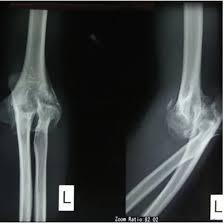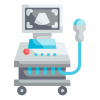Book an Appointment
NCCT for Left Elbow
Medifyhome has collaborated with the best pathology laboratories that are NABL and NABH certified and follow ISO safety guidelines to provide the best NCCT for Left Elbow at an affordable price for needy individuals. Non-Contrast Computed Tomography (NCCT) is an enhanced imaging model that offers significant data of the osseous districts of the body, particularly the joint of the elbow. The elbow is a significant joint of the human skeletal system, which allows the extension and flexion of the extremities involved. It can also develop fractures, dislocations, arthritis, and tumors. NCCT is particularly beneficial for generating cross-sectional images in detail with no need for contrast, and is safe for the patients it serves. This method is quite detailed and enables the practitioner to gain the needed perspective of complicated structures to facilitate accurate diagnosis of the potential problem and choose an appropriate treatment plan. To schedule an appointment for an NCCT for the Left Elbow, contact Medifyhome or call our customer care at +919100907036 or +919100907622 for more details and queries.
What is NCCT?
SPECT, or Single Photon Emission Computed Tomography, is a special type of imaging that is based on the use of X-rays to create detailed images of the body without using dyes or contrast agents known as NCCT or Non-Contrast Computed Tomography. Unlike conventional CT scans, where the subject might be injected with contrast media to help highlight the tissues of interest, NCCT centres on getting good images based solely on X-ray absorption. NCCT scans are obtained with the help of a series of images collected in one plane with the help of X-ray images. Subsequently, connected images are analysed by a computer to create detailed cross-sections of the area under study. Usual in examinations for fractures, tumors, infections, or diseases that involve bones and soft tissues. It is very useful, especially in an emergency where the assessment has to be done very fast. The application of NCCT scans is usually rapid and therefore is favorable in emergency cases. Especially beneficial for reading particularities at the joints, such as fingers and wrist bones, spine, etc. Assists in diagnosing tumours that affect the bones, infections, as well as degenerative diseases. Does not require the use of contrast agents to identify trauma or acute conditions in the first instance.
Indications for NCCT of the Left Elbow
Here are the common indications for performing NCCT (Non-Contrast Computed Tomography) of the left elbow:
- Trauma and Fractures
Assessment of Fractures: Successfully employed for diagnosing and distinguishing fractures of the humerus, radius, ulna, and in difficult cases, as well as in cases when the X-ray examination proved to be ineffective.
Evaluation of Intra-Articular Fractures: Aids in the evaluation of fractures in the region of the elbow and stability of the joint.
- Dislocations
Confirmation of Dislocations: Critically important to both confirm the stability of the elbow dislocation and diagnose any underlying osseous abnormalities.
- Osteomyelitis
Detection of Bone Infections: Previously employed for evaluation of osteomyelitis in terms of bone marrow extension and adjacent tissue alterations.
- Tumors and Lesions
Identification of Tumors: Assists in the confirmation of primary malignant bone tumors, metastatic lesions, or benign tumor growth in the elbow area.
Characterization of Bone Lesions: Discriminating between benign and malignant lesions while relying on imaging characteristics.
- Arthritis and Degenerative Changes
Evaluation of Inflammatory Arthritis: Helpful where it is necessary to evaluate inflammation of the joints, such as in rheumatoid arthritis or any other inflammation of the elbow joint.
Assessment of Osteoarthritis: Recognition of joint space narrowing and the appearance of bone spurs and other destructive changes.
- Pre-Operative Planning
Surgical Planning: Gives fine images suitable for use in preparation for surgeries like fracture surgery or tumor excision particularly in complicated situations.
- Post-Operative Evaluation
Assessment of Surgical Outcomes: Done to determine whether surgeries were effective, as well as ensuring that structures were aligned correctly or sutured properly, or whether signs of inflammation or infection are present.
- Chronic Pain Evaluation
Investigation of Unexplained Pain: Memorable in diagnosing chronic elbow pain or discomfort when other imaging procedures have not been helpful.
- Screening of Ligamentous Injuries
Evaluation of Soft Tissue: While primarily diagnostic of bony structures, NCCT may help evaluate ligament status in instances of acute injury around the elbow joint.
Procedure for the NCCT left elbow.
Here’s a step-by-step outline of the NCCT (Non-Contrast Computed Tomography) procedure for the left elbow:
- Preparation
Patient Assessment: The healthcare provider should go through MRI examination of the patient and if the patient has undergone other imaging tests in the past.
Clothing and Accessories: Depending on the imaging modality the patient is required to undress and put on a hospital gown and all metallic items such as jewelry, watch and other ferromagnetic items are removed from the body.
- Positioning
Patient Positioning: Supine patient of The patient on the CT scanner table, and only the left elbow has to be positioned in the scanning zone.
Stabilization: This if necessary; the left arm of the patient may be positioned on a supporting pad to minimize movement during scanning.
- Scanning Process
Scanner Setup: The CT machine is set depending on which aspect of the human body one wants to image. The technician makes certain that he or she has placed the elbow in the right position.
Breath-Holding Instructions: Specifically, during the scan of the elbow a patient can be asked to suspend his/her breathing for some amount of time in an effort to eliminate motion related effects.
Image Acquisition: The scanner rotates around the elbow and captures consecutive sections of respective images. In some cases, this process is fairly rapid, and a few minutes are usually sufficient.
- 3D Reconstruction is in the given input.
Image Processing: The obtained images are then transferred into a computer and can be used to reconstruct different structures of the elbow joint in three dimensions.
Enhanced Visualization: Radiographers can rotate these images to view the elbow from a variety of positions, increasing the visibility of the bony structures and pathology.
- Post-Procedure Care
Recovery: The benefit of the procedure is that most of the patients can return to their normal activities right after the examination since no contrast media is employed.
Results: The radiologist interprets the images and writes a report to the doctor who referred the patient, and who will then explain the results to the patient.
Advantages of NCCT for Elbow Imaging
- High-Resolution Imaging
Enables precise delineation of the bony anatomy of the elbow and reveals fractures, dislocations, and other pathologic conditions.
- Most of the time, three-dimensional reconstruction is used.
Allows for reconstructed images that provide a complete view of the elbow joint and surrounding anatomy that is valuable when dealing with high kinetic chain injuries.
- No Contrast Agents Required
Less dependency on contrast materials, and a relative reduction in allergy prone cases, and complications caused there by particularly in renal compromised patients.
- Rapid Scanning Process
The scanning procedure is less time-consuming and usually lasts several minutes only; that is especially important for patient care in clinical practice.
- Improved Diagnostic Accuracy
It reduces the time needed to diagnose diseases for conditions like fractures, arthritis, and tumors better than normal X-rays.
- Low Radiation Exposure
New technologies are much safer for patients compared to older traditional methods.
- Most helpful in instances where the injury is complicated
Most valuable in the evaluation of compound fractures and intra-articular findings, giving essential information to the treatment plan.
- The following is a critical analysis of chronic conditions as discussed in the scholarly articles.
Useful in evaluating common elbow pathologies, including degenerative disorders and soft tissue damage, for treatment planning.
- Enables Preliminary and Post-Nested Operation Preparation
Gives clear pictures used by surgeons to map their operations and assess the levels of damage once operations are carried out.
- Patient Comfort
This process is noninvasive and usually well endured, which is considered to enhance the patient experience when being imaged.
Interpreting the Results
- Initial Image Review
Radiologist Assessment: A radiologist will then evaluate the 3D reconstructed images of the shoulder to ensure that overall appearance is normal or if there is any deformity.
Comparison with Previous Studies: Depending on the Kensington current images, comparison with the previous images may enable assessment of the changes caused by the disease.
- Structural Analysis
Bony Anatomy: The radiologist will scrutinize the clavicle, scapula, humerus and all jig Glowing structures attached on the upper limb taking keen attention on establishe bony annotations.
Joint Spaces: Assessment of joint space for any sign of joint space narrowing as evidenced by arthritic or other degenerative diseases.
- Detection of Abnormalities
Fractures: There may be difficulties in diagnosing distal radius fractures, especially fractures that might be small or complicated making them invisible on a plain X-ray.
Dislocations: Physical examination to determine if there are cases of dislocations, and if there are, assessment of their damage.
Bone Lesions: Suspected tumours, cysts, or any other abnormality that may need further investigation.
- Examination and interpretation of Soft Tissues (if any)
While the primary structures of interest at NCCT are bony structures, the radiologist might also look for signs of soft tissue abnormalities that might have resulted from rotator cuff pathology.
- The evaluation of related conditions
Impingement: Search for the bony spurs or changes in the acromion could be expected in the impingement syndromes.
Joint Stability: Assessment of the presence and severity of some forms of instability and other pathologies of the shoulder joint.
- Reporting Findings
Detailed Report: Besides interpretation, the radiologist will dictate him/herself a report that will encompass the imaging study, findings, any abnormalities noted, the implications of these abnormalities, if any, management or follow-up recommendation.
Visual Aids: There should be tables when presenting the survey results, as well as graphs, annotated images or even 3D models with the description of the analyzed sections.
- Test Type: NCCT for Left Elbow
- Preparation:
- Wear a loose-fitting cloth
- Fasting not required
- Carry Your ID Proof
- Prescription is mandatory for patients with a doctor’s sign, stamp, with DMC/HMC number; as per PC-PNDT Act
- Reports Time: With in 3-4 hours
- Test Price: Rs.3000
How can I book an appointment for an NCCT for the Left Elbow through Medifyhome?
To schedule an appointment for a NCCT For Left Elbow, simply contact Medifyhome or call our customer care at +919100907036 or +919100907622 for more details and queries.
What is NCCT?
NCCT is computer tomography that examines human body cross-sectional images using X-rays without the use of contrast agents. It is most effective when used to make positron emission tomography (PET) scans of bony structures.
Why is North Carolina Computerized Tomography (NCCT) used for the assessment of the elbow joint?
NCCT can be employed for elbow imaging to give images with good accuracy for diagnosis of conditions such as fractures, dislocations, infections, and tumors, where routine X-rays cannot suffice.
What are the conditions that this test, called NCCT, can assist with diagnosing?
It is possible for NCCT diagnosis of a wide range of diseases including fracture, dislocation, osteomyelitis, tumor and degenerative diseases such as arthritis.
How much time does the NCCT scan take to complete?
Scanning on average takes only a few minutes to complete. Although the control process itself is brief, the entire appointment could take longer, thanks to preparation and positioning.
Is the scan prepared in any special way for the scan?
In most cases, clients do not require any preparations for the treatments offered by a dermatologist. It is important for patients to be comfortable dressing and may be required to remove all metallic items on him or her. Priorities should be told to the technician, diseases included, allergies as well as any other ailment.
Is it painful to have the procedure done?
The NCCT scan is more specific than the X ray and is not an invasive or painful procedure. Sometimes the patient might have to remain still for a few minutes but there should be no pain at all involved.
Are there any risks associated with NCCT?
The major danger arises from exposure to radiation; however, medical advancement in designing new generation NCCT equipment has reduced radiation exposure as compared to the use of old technology. There are no contraindications regarding contrast agents for the reason that no contrast agent is employed.
What form will the results be delivered in?
The radiologist has to study the images and prepare a report that will then be forwarded to the physician who referred the patient. The physician will explain the results to you and what further actions may be required.
Could NCCT help in surgical planning?
Indeed, NCCT has been employed both in pre-operative assessment and in post-operative assessment with important diagnostic information about the anatomy and pathology affecting surgical operations.
Most Booked Ct Scan Parts
With Medifyhome, book a CT scan get the fastest appointment scheduling at NABH & ICMR Certified diagnostic centers near you. Trusted reports, expert radiologists, and seamless service-only a click away!
Why Choose Medifyhome for NCCT for Left Elbow?
Medifyhome is an online medical consultant that provides home-based medical services not only in your area but also in most cities in India, including Hyderabad, Chennai, Mumbai, Kolkata, and more. We have collaborated with diagnostic centers that have the best machines and equipment to ensure you get accurate results. Medifyhome provides 24-hour customer service for booking the appointment of the services and guides you with instructions. Medifyhome also provides the best diagnostic centers at low prices. Once you receive your test results, you can easily book an appointment with our network of experienced doctors for consultation. To schedule an appointment for a NCCT For Left Elbow, simply contact Medifyhome or call our customer care at +919100907036 or +919100907622 for more details and queries.













